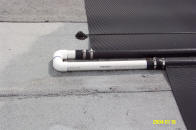|








| |
4.
INSTALL SOLAR LOOP PIPING
- All panels should be plumbed together using 2" Sch. 40 PVC.
- 1.5" can be used on smaller systems (<6 panels) with short pipe runs
(< 75' total).
- Never use ABS piping for solar systems.
- ABS does not hold-up well to UV and is not designed for
pressurized systems
- Properly and carefully glue all your pipe/fitting joints with
glue less than 6 months old
- We are "old school" and prefer you use a primer and glue
combination
- Instead of "hot" glues that supposedly do both.
- Use glue that is as slow to set-up as your skill level requires.
- Clear glues and primers are nice since drips are less visible
- Clear glue is easy to find at Home Depot and Lowe's often has
clear primer.
- Purple primer is easy to see on your pipe but difficult to remove if
spilled-BE CAREFUL
- Where necessary, always lay-out your roof piping with drainage in
mind if needed.
- In cooler climates, you want to make sure the panels and the piping can drain
completely either manually or automatically as needed.
- Install drain valves (hose bibbs) as needed DON'T PUT DRAIN VALVES
ON ROOF.
- Recommend installing drain valves so they can be accessed from
ground
- run 1/2" PVC from roof to accessible location
- It is best to put drain valves down by pool equipment area putting
one on each line on the panel side of any isolation ball valves if
used. See next section).
- Freeze damage is avoidable and NOT covered by manufacturer's
warranty
- Use FAFCO CPVC female
adapter at every pipe/panel connection.
- Otherwise, pressure of clamps at panel rubber couplers can deform
the piping during stagnation conditions allowing pipe to push-out of
rubber couplers at any time.
- You need four female adapters wherever panels need to split around
roof obstructions such as sky lights, chimneys, roof vents, etc.
- Plumb panels in parallel to equalize flow per panel and
maximize performance
- Never run outlet (return) of one panel or bank into input (feed) of
another--series flow
- See pictures below showing piping diagrams
- Diagonally feed and return single banks if possible (see
diagrams below)
- That is, ideally, feed each panel bank to the far lower corner
and return from the closer upper corner
- This shortens the return piping and thus reduce any potential heat
loss
- Ensures every panel gets the same flow
- No possibility of short-cycling of flow
- For multiple panel banks when one bank is above the other, USE "common high-point return" policy
- That is, return all panel banks to a common high point before final
return to pool
- See example of double-banked panels below
- Avoid relying on valves in solar loop to balance flow on residential
systems
- Put vacuum relief valve in an upper unused corner. NOT NEEDED
IN HAWAII.
- Use end caps to plug any remaining unused panel corners.
- Double-check that all stainless steel band clamps are tight
- If you use a rachet or drill to tighten, be careful not to strip the
clamp
- It is best for the PVC to be painted if exposed to UV
- It also is more aesthetic when painted either black or to match the
roof or wall color
- Be sure to clamp the pipe as needed to keep it from sagging or flexing
over time.

|
|
| Common panel configurations and how they should be
plumbed if possible. |
| Note that the feed pipe should be taken to the far lower
corner of the panel bank so that the return pipe is shorter
going back to the pool thus reducing heat loss. |
|
|
|
|
|

|
|
| Example of series flow that should be avoided |
| |
|
|
|
|
|
|
|
|
|
|

|
|
|
|
Pipe/panel connection with female adapter |
|
|
|
|
|
|
|
|

|
|
|
|
Female adapters used at split around roof obstruction |
|
|
|
|
|
|
|
|
|
|
|
Copyright © 2001
ecosystems.
All rights reserved.
Page last updated:
May 04, 2020
|

